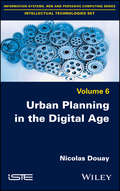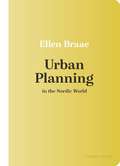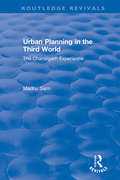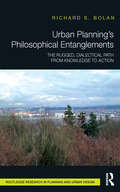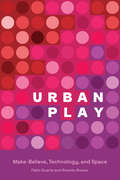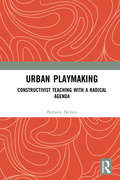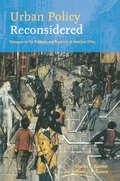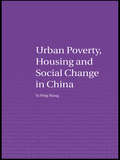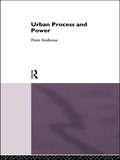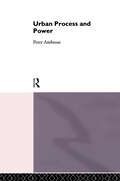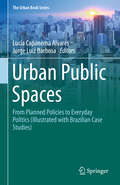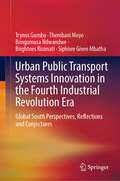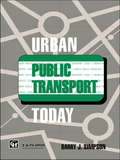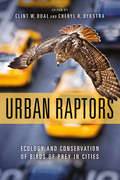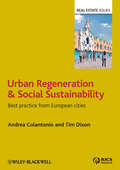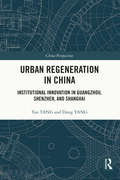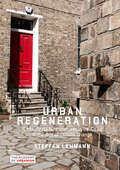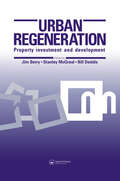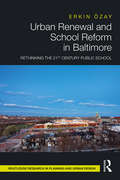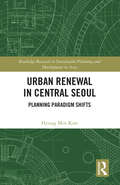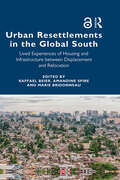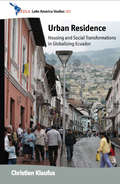- Table View
- List View
Urban Planning in the Digital Age: From Smart City to Open Government?
by Nicolas DouayTechnological changes have often produced important social changes that translate into spatial and planning practice. Whereas the intelligent city is one of the unavoidable and even dominant concepts, digital uses can influence urban planning in four different directions. These scenarios are represented by a compass composed of a horizontal axis opposing institutional and non-institutional actors, and a second axis with open and closed opposition.
Urban Planning in the Nordic World (Nordic World)
by Ellen BraaeThis book outlines the origins, development, challenges, and lived realities of the changing welfare city, focusing primarily on Denmark. Strategies have changed over the decades as models of development have shifted and as the needs of society and a warming planet have come into focus. The role of the state has been minimized, turning municipalities into the new major agents in attracting taxpayers and providing goods—both by means of urban planning.
Urban Planning in the Third World: The Chandigarh Experience (Routledge Revivals)
by Madhu SarinOriginally published in 1982 Urban Planning in the Third World is concerned with some of the critical issues underlying urban planning in the Third World. Taking the specific case of Chandigarh, planned or rather ‘designed’ by Le Corbusier as the new capital of Punjab following Partition, the author describes the development of the city, showing how concepts inherent in the master plan and the policies pursued in its implementation not merely ignored, but totally excluded a major section of the population from ‘legal’ housing and employment. The book sets a distinct theoretical framework, examining the Indian context at the time of Independence, the Western origins of the planning concepts applied in the city, and the process by which Le Corbusier finalized its master plan in a matter of days. The book also examines the social forces determining the temporary resolution of inherent conflicts in the plan and examines the growth of non-plan settlements in the city and the impact of the plan on the lives of the settlement residents.
Urban Planning’s Philosophical Entanglements: The Rugged, Dialectical Path from Knowledge to Action
by Richard S BolanUrban Planning’s Philosophical Entanglements explores the long-held idea that urban planning is the link in moving from knowledge to action. Observing that the knowledge domain of the planning profession is constantly expanding, the approach is a deep philosophical analysis of what is the quality and character of understanding that urban planners need for expert engagement in urban planning episodes. This book philosophically analyses the problems in understanding the nature of action — both individual and social action. Included in the analysis are the philosophical concerns regarding space/place and the institution of private property. The final chapter extensively explores the linkage between knowledge and action. This emerges as the process of design in seeking better urban communities — design processes that go beyond buildings, tools, or fashions but are focused on bettering human urban relationships. Urban Planning’s Philosophical Entanglements provides rich analysis and understanding of the theory and history of planning and what it means for planning practitioners on the ground.
Urban Play: Make-Believe, Technology, and Space
by Fabio Duarte Ricardo AlvarezWhy technology is most transformative when it is playful, and innovative spatial design happens only when designers are both tinkerers and dreamers.In Urban Play, Fábio Duarte and Ricardo Álvarez argue that the merely functional aspects of technology may undermine its transformative power. Technology is powerful not when it becomes optimally functional, but while it is still playful and open to experimentation. It is through play--in the sense of acting for one's own enjoyment rather than to achieve a goal--that we explore new territories, create new devices and languages, and transform ourselves. Only then can innovative spatial design create resonant spaces that go beyond functionalism to evoke an emotional response in those who use them. The authors show how creativity emerges in moments of instability, when a new technology overthrows an established one, or when internal factors change a technology until it becomes a different technology. Exploring the role of fantasy in design, they examine Disney World and its outsize influence on design and on forms of social interaction beyond the entertainment world. They also consider Las Vegas and Dubai, desert cities that combine technology with fantasies of pleasure and wealth. Video games and interactive media, they show, infuse the design process with interactivity and participatory dynamics, leaving spaces open to variations depending on the users' behavior. Throughout, they pinpoint the critical moments when technology plays a key role in reshaping how we design and experience spaces.
Urban Playground: How Child-Friendly Planning and Design Can Save Cities
by Tim GillWhat type of cities do we want our children to grow up in? Car-dominated, noisy, polluted and devoid of nature? Or walkable, welcoming, and green? As the climate crisis and urbanisation escalate, cities urgently need to become more inclusive and sustainable. This book reveals how seeing cities through the eyes of children strengthens the case for planning and transportation policies that work for people of all ages, and for the planet. It shows how urban designers and city planners can incorporate child friendly insights and ideas into their masterplans, public spaces and streetscapes. Healthier children mean happier families, stronger communities, greener neighbourhoods, and an economy focused on the long-term. Make cities better for everyone.
Urban Playmaking: Constructivist Teaching with a Radical Agenda
by Bethany NelsonThis book explores the concept of playmaking and activism through three research projects in which culturally and linguistically diverse high school students and young adults created original theatre around the issues that inform their lives and constrain their futures. Each study discussed by the author is considered through the lens of one or more best practices. The outcomes of the playmaking experiences, communicated through detailed ethnographic data and the voices of student participants, make a strong case for using what we already know about teaching to positively impact gross inequities of outcome for culturally and linguistically diverse students. This study will be of great interest to students, scholars, and practitioners in Applied Theatre, Theatre Education, and Art Therapy.
Urban Policy Reconsidered: Dialogues on the Problems and Prospects of American Cities
by Charles Euchner Stephen McGovernIn the past decade, America has experienced an urban renaissance. Cities as varied as New York, Chicago and Boston are no longer seen as ungovernable and doomed to crime and blight. However, they still face formidable problems. Urban Policy Reconsidered is a comprehensive overview of the issues and problems facing our cities today and cover every important issue in urban affairs. What is poverty? What is economic development? What is education? What is crime? As well as covering all of these fundamental topics in-depth, the author propose a communitarian approach to addressing the many problems of our cities. This book will be the manual for anyone interested in understanding urban policy.
Urban Poverty, Housing and Social Change in China (Housing and Society Series)
by Ya Ping WangEconomic reform in China has resulted in a widening gap between the rich and the poor, and urban poverty has emerged as a key factor which may affect future development. This new book examines the poverty problem in relation to housing and social changes in large inland cities, and assesses the effectiveness of recent government anti-poverty policies. The book also puts the Chinese experience in the wider context of transitional economies and discusses the similarities and differences between China and Central and Eastern European countries. The book is based on a long period of research on Chinese urban development, and benefited from several research projects conducted in Chinese cities. It is an important reference for all of those interested in housing, urban studies and social change, and is a key text for students of the Chinese economy and society.
Urban Process and Power
by Peter AmbroseUrban Process and Power has two chief aims. Firstly, it analyses and explains a century of the production and reproduction of the urban environment in which most of us live. Secondly, the book focuses on recent changes in the control of these processes and the ideology that has brought these changes about. Immense disparities exist between the "best" and the "worst" urban areas in Britain. Why do these differences arise and how are they perpetuated? The author argues that the growth of such inequality is linked to questions of accountability and the increasing erosion of a democratic principle in the urban process.
Urban Process and Power
by Peter AmbroseUrban Process and Power has two chief aims. Firstly, it analyses and explains a century of the production and reproduction of the urban environment in which most of us live. Secondly, the book focuses on recent changes in the control of these processes and the ideology that has brought these changes about. Immense disparities exist between the "best" and the "worst" urban areas in Britain. Why do these differences arise and how are they perpetuated? The author argues that the growth of such inequality is linked to questions of accountability and the increasing erosion of a democratic principle in the urban process.
Urban Public Spaces: From Planned Policies To Everyday Politics (illustrated With Brazilian Case Studies) (The Urban Book Series)
by Lucia Capanema Alvares Jorge Luiz BarbosaThis book is about understanding, contextualizing and carrying out critical analyzes of the policies intended and/or implemented by the various public and private actors in urban public spaces, as well as the daily, or eventual, politics exercised by the organized civil society and by citizens. It presents a collection of contributions about the public space in different theoretical, conceptual and methodological approaches. Coming from different disciplines, the authors share an understanding about the need to analyze the uses and appropriations of the city by social subjects and groups as they represent difference and see the city as a place to share life experiences; as such, they argue, through their cases studies, that places of public use should be thought of and understood as concept and as social practice. As an analytic tool, the book offers a five-dimension model to explore how people relate to daily life activities and confront imposed inequalities in their meeting places, how they engage in individual and collective manifestations and/or how they symbolically appropriate public spaces in face of the late capitalism led by large corporations and globalization. Together the authors seek to contribute to a city of utopia, where all differences can be seen and dealt with in public spaces and where free individuals can present themselves and engage in a vita activa.
Urban Public Transport Systems Innovation in the Fourth Industrial Revolution Era: Global South Perspectives, Reflections and Conjectures
by Trynos Gumbo Thembani Moyo Bongumusa Ndwandwe Brightnes Risimati Siphiwe Given MbathaThis book explores the physical and electronic integration of innovative urban public transport systems in seven metropolitan cities in South Africa and Zimbabwe in the era of the Fourth Industrial Revolution (Industry 4.0). The book also highlights how collaborative engagement can improve new transport projects in cities of the Global South. It demonstrates how integration concerns remain in transport infrastructure projects in cities of the developing countries. Consequently, in order to strengthen the emerging and promising economies of these cities, there is a need for efficient, integrated, reliable and affordable public transport systems. The book explains that plans to deliver innovative transport systems in the Global South need to be well coordinated and managed to yield physically and electronically integrated systems.
Urban Public Transport Today
by B. Simpson Dr Barry SimpsonThis book is about how local public transport can be made a less unacceptable alternative to the private car than it is now. It is intended for officials, politicians and others interested in the land use/local transport conundrum. It is also valuable to town planners, those working for passenger transport authorities and anyone concerned with policy making and project appraisal for local public transport.
Urban Quilting: Quilt Patterns For The Modern-day Home
by Wendy ChowPerfect for beginners, this quilting book features simple illustrations and easy-to-follow steps that teach you how to make up to 30 beautiful quilts in a short amount of time! A comprehensive guide for both first-time quilters and those looking for a refresher course, Urban Quilting teaches you everything you need to know about this timeless craft. Each pattern contains instructions for three different quilt sizes, with designs that feature bold colors and geometric shapes that will stand out and look stunning in your home. Urban Quilting includes: • 10 quilt designs, each with patterns for 3 sizes, for making up to 30 quilts • Beginner-friendly content, including everything you need to know to get started • Detailed instructions with clear diagrams so you can learn quickly and easily • Insightful information on the history of quilting and how today's quilters are modernizing the craft
Urban Raptors: Ecology and Conservation of Birds of Prey in Cities
by Clint W. Boal Cheryl R. DykstraRaptors are an unusual success story of wildness thriving in the heart of our cities—they have developed substantial populations around the world in recent decades. But there are deeper issues around how these birds make their urban homes. New research provides insight into the role of raptors as vital members of the urban ecosystem and future opportunities for protection, management, and environmental education.A cutting-edge synthesis of over two decades of scientific research, Urban Raptors is the first book to offer a complete overview of urban ecosystems in the context of bird-of-prey ecology and conservation. This comprehensive volume examines urban environments, explains why some species adapt to urban areas but others do not, and introduces modern research tools to help in the study of urban raptors. It also delves into climate change adaptation, human-wildlife conflict, and the unique risks birds of prey face in urban areas before concluding with real-world wildlife management case studies and suggestions for future research and conservation efforts.Boal and Dykstra have compiled the go-to single source of information on urban birds of prey. Among researchers, urban green space planners, wildlife management agencies, birders, and informed citizens alike, Urban Raptors will foster a greater understanding of birds of prey and an increased willingness to accommodate them as important members, not intruders, of our cities.
Urban Regeneration and Social Sustainability: Best Practice from European Cities (Real Estate Issues #53)
by Andrea Colantonio Tim DixonUrban regeneration is a key focus for public policy throughout Europe. This book examines social sustainability and analyses its meaning. The authors offer a comprehensive European perspective to identify best practices in sustainable urban regeneration in five major cities in Spain, Italy, Netherlands, Germany, and the UK. This authoritative overview of the scholarly literature makes the book essential reading for researchers and post-graduate students in sustainable development, real estate, geography, urban studies, and urban planning, as well as consultants and policy advisors in urban regeneration and the built environment.
Urban Regeneration in China: Institutional Innovation in Guangzhou, Shenzhen, and Shanghai (China Perspectives)
by Yan Tang Dong YangThe book examines institutional innovation in urban regeneration in Guangzhou, Shenzhen, and Shanghai, three Chinese cities that have experienced sweeping changes in recent years, providing an ideal guide to the development of urban regeneration practices in China. As a starting point, the book revisits relevant theoretical developments and the institutional experiences of urban regeneration in some Asian pioneer cities and regions, such as Hong Kong, Taipei, Tokyo, and Singapore. Moving on to the Chinese mainland cities themselves, the core comparative study investigates the institutional systems, key policies, planning formulations, and implementation paths in the urban regeneration process of the three cities. Gains and losses that have resulted from each city's institutional construction and reformation are discussed, as well as the underlying reasons for these. Drawing on these case studies and comparisons, the book puts forward some generic rules for urban regeneration institutional innovation, offering a valuable frame of reference for other cities and regions. The book will appeal to scholars interested in urban regeneration and renewal, as well as urban planners, architects, policymakers, and urban development administrators.
Urban Regeneration: A Manifesto for transforming UK Cities in the Age of Climate Change
by Steffen LehmannUrban Regeneration — A Manifesto for transforming UK Cities in the Age of Climate Change explores and offers guidance on the complex process of how to transform cities, continuing the unfinished project of the seminal 1999 text Towards an Urban Renaissance. It is a 21st-century manifesto of urban principles compiled by a prominent urbanist, for the regeneration of UK cities, focusing on the characteristics of a ‘good place’ and the strategies of sustainable urbanism. It asks readers to consider how we can best transform the derelict, abandoned and run-down parts of cities back into places where people want to live, work and play.The book frames an architecture of re-use that translates and combines the complex ‘science of cities’ and the art of urban and architectural design into actionable and practical guidance on how to regenerate cities. Fascinated by the typology and value of the compact UK and European city model, Lehmann introduces the concept of ‘high density without high buildings’ as a solution that will make our cities compact, walkable, mixed-use and vibrant again.
Urban Regeneration: Property Investment and Development
by Stanley McGreal Jim Berry Bill DeddisThis book provides an in-depth analysis of the role of property investment and development in the urban regeneration process. It relates the physical, economic, financial and environmental aspects of urban change and development to the realities of particular cities by case studies drawn from Britain and Europe.
Urban Renewal and School Reform in Baltimore: Rethinking the 21st Century Public School
by Erkin ÖzayUrban Renewal and School Reform in Baltimore examines the role of the contemporary public school as an instrument of urban design. The central case study in this book, Henderson-Hopkins, is a PK-8 campus serving as the civic centerpiece of the East Baltimore Development Initiative. This study reflects on the persistent notions of urban renewal and their effectiveness for addressing the needs of disadvantaged neighborhoods and vulnerable communities. Situating the master plan and school project in the history and contemporary landscape of urban development and education debates, this book provides a detailed account of how Henderson-Hopkins sought to address several reformist objectives, such as improvement of the urban context, pedagogic outcomes, and holistic well-being of students. Bridging facets of urban design, development, and education policy, this book contributes to an expanded agenda for understanding the spatial implications of school-led redevelopment and school reform.
Urban Renewal in Central Seoul: Planning Paradigm Shifts (Routledge Research in Sustainable Planning and Development in Asia)
by Hyung Min KimKim details a brief history of urban renewal in central Seoul through articulating urban planning paradigm shifts. This book illustrates four main themes in central Seoul: the restoration of the Cheonggye stream, the redevelopment of the Sewoon Plaza, the enhancement of walkability and public transport networks, and history- centred urban renewal.Urban renewal is seen as a remedy for urban sprawl and is appreciated for its capacity to make use of pre-existing infrastructure and cultural assets in high- density urban areas. However, it faces critical challenges, such as fragmented property ownership and escalated land prices in comparison with peri- urban areas. The book focuses on how planning policies have shaped the urban renewal process in central Seoul, South Korea. Spatial development policies for central Seoul have been changed from modern transport facilities, post- war reconstruction, informality, industrialisation to walkability, sustainability, and social cohesion in line with economic restructuring. In recent times, there has been a significant change in thinking towards creating public spaces for walking, preserving historical sites and heritage, and maintaining green spaces. These interconnected topics contribute to understanding the complexity of urban renewal.This book is a useful read for researchers on urban planning and policies who are keen to understand the complicated process of urban renewal and ways to revitalise economic and human activities and transform built environments.
Urban Resettlements in the Global South: Lived Experiences of Housing and Infrastructure between Displacement and Relocation
by Raffael BeierUrban Resettlements in the Global South provides new perspectives on resettlement through an urban studies lens. To date, resettlement has been theorised through development studies and refugee studies, but urban resettlement is also a major dimension of urban development in the Global South and may help to rethink contemporary urban dynamics between spectacular new town developments and rising incidences of eviction and displacement. Conceptualising resettlement as a binding notion between production/regeneration and destruction/demolition of urban space helps to illuminate interdependencies and to underline significant ambiguities within affected people’s perspectives towards resettlement projects. This volume will offer an interesting selection of ten different case studies with rich empirical data from Latin America, North and Sub-Saharan Africa, and Asia, focused on each stage of resettlement (before, during, after relocation) through different timescales. By offering a frame for analysing and rethinking resettlement within urban studies, it will support any scholar or expert dealing with resettlement, displacement, and housing in an urban context, seeking to improve housing and planning policies in and for the city.
Urban Residence
by Christien KlaufusRiobamba and Cuenca, two intermediate cities in Ecuador, have become part of global networks through transnational migration, incoming remittances, tourism, and global economic connections. Their landscape is changing in several significant ways, a reflection of the social and urban transformations occurring in contemporary Ecuadorian society. Exploring the discourses and actions of two contrasting population groups, rarely studied in tandem, within these cities--popular-settlement residents and professionals in the planning and construction sector--this study analyzes how each is involved in house designs and neighborhood consolidation. Ideas, ambitions, and power relations come into play at every stage of the production and use of urban space, and as a result individual decisions about both house designs and the urban layout influence the development of the urban fabric. Knowledge about intermediate cities is crucial in order to understand current trends in the predominantly urban societies of Latin America, and this study is an example of needed interdisciplinary scholarship that contributes to the fields of urban studies, urban anthropology, sociology, and architecture.
Urban Retrofitting for Sustainability: Mapping the Transition to 2050
by Tim Dixon Malcolm Eames Miriam Hunt Simon LannonWith a foreword from Paul King, Chief Executive, UK Green Building Council and Chairman, Zero Carbon Hub As concerns over climate change and resource constraints grow, many cities across the world are trying to achieve a low carbon transition. Although new zero carbon buildings are an important part of the story, in existing cities the transformation of the current building stock and urban infrastructure must inevitably form the main focus for transitioning to a low carbon and sustainable future by 2050. Urban Retrofitting for Sustainability brings together interdisciplinary research contributions from leading international experts to focus on key issues such as systems innovation, financing tools, governance, energy, and water management. The chapters consider not only the knowledge and technical tools available, but looks forward to how they can be implemented in real cities by 2050.
